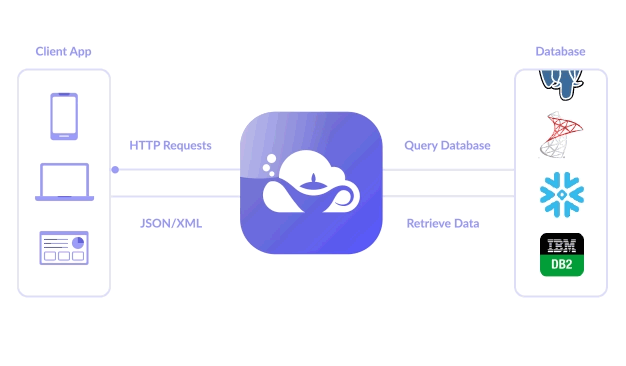

In today's rapidly evolving digital landscape, companies constantly seek innovative ways to modernize existing systems and harness the true potential of their data.
The good news is that the perfect marriage of API generation and data mesh strategies provides an answer to these challenges. This powerful duo transforms how you access, manage, and deploy your data, breathing new life into irrelevant infrastructures.
In this article, we explore how API generation bridges the gap between legacy and modern systems while enabling a successful data mesh implementation. Dive in to unlock the immense value latent within your organization's data and propel your business toward a more efficient, data-driven culture.
API generation is the process of automatically creating an application programming interface (API) using tools and software. An API is a set of protocols and rules that allow different software applications to communicate and exchange data. With API generation, you can create APIs without writing code manually, making the process fast and efficient.
API platforms often come with a range of features and functionality to help organizations manage their APIs. For example, some tools offer API management capabilities that empower companies to track API usage, monitor performance, and manage access control. Others may include auto-documentation features that automatically generate documentation for APIs so developers more easily understand how to use them.
APIs make data accessible and available to different software applications in a secure and controlled manner. They act as intermediaries between software applications, allowing them to share data seamlessly and without compromising security.
For example, a healthcare provider may use an API to access patient information and medical data from a database, then build a patient dashboard to display personalized treatment plans and health recommendations to patients. Similarly, analytics software may use an API to extract data from different sources, analyze it, and provide insights to stakeholders.
APIs have become increasingly important in modern data-driven organizations for several reasons.
However, modernizing legacy systems and databases to be API-first can be challenging, especially in highly-regulated industries like healthcare or finance. In these cases, it's crucial to ringfence legacy databases and use an on-prem API gateway to protect sensitive data. Additionally, following REST API best practices is essential to ensure security and scalability.
Data mesh is a relatively new approach to data architecture that emphasizes decentralizing data ownership, governance, and distribution. It responds to the limitations of traditional centralized data warehouses, which can be inflexible, expensive to maintain, and difficult to scale.
Data mesh strategies often envision data as a product, with each domain or business unit responsible for creating, maintaining, and sharing its own products. This approach is similar to how microservices break down monolithic applications into smaller, more modular services. By decentralizing data ownership and governance, businesses create a more flexible and adaptable data infrastructure better suited to the company’s needs.
Instead of relying on a centralized team of data experts to manage all data-related tasks, data mesh encourages cross-functional teams to take ownership of their domains. This not only facilitates self-serve data infrastructure but also gives teams greater control over their data, making it easy for them to innovate more quickly.
Implementing data mesh strategies offers several benefits, including:
Overall, data mesh represents a significant shift in how organizations approach data management. Many are exploring data mesh as a way to create a more agile, responsive, and efficient infrastructure to better support their business goals.
Standardizing access is key to speeding up data access, but first, let us understand how API generation works.
Unlike hand-coding APIs, creating APIs using the API generation software only requires two simple steps. First, organizations must identify the data sources they want to expose through APIs.
Once identified, generation tools create a set of ready-to-use APIs. These tools also include API management, auto-documentation, security features, and REST API best practices support.
Data is exposed through standardized APIs that can be accessed by any authorized application, regardless of its underlying technology. This makes sharing data across the organization easier, eliminating data silos and reducing the risk of inconsistencies.

Source: DreamFactory
By creating a standard interface for accessing data, API generation eliminates the need for different teams to maintain their own data storage and access mechanisms. This also lowers the risk of data inconsistencies, improves data quality, and enhances collaboration across departments.
In addition, API generation lets organizations set up microservices-based architectures that improve their adaptability. You can build applications as a set of small, modular services that talk through APIs to create a more flexible and scalable architecture. This approach helps organizations modernize legacy systems and databases, creating a more efficient and unified data ecosystem.
API generation modernizes systems in two ways: bridging the gap between legacy and modern systems and enhancing the value of existing systems and data. Let's see how.
Transitioning from legacy to modern systems is the first step in building a better data architecture.
Legacy systems were often designed to operate in isolation, with limited support for data sharing or integration with modern systems. As a result, accessing data stored in legacy systems is time-consuming, error-prone, and difficult to scale.
One of the biggest challenges of legacy systems is that they often rely on outdated technologies and protocols that aren’t compatible with modern data management tools and platforms. For example, many legacy systems use SOAP-based web services, which can be difficult to integrate with modern REST-based APIs.

Source: DreamFactory
This is where API generation comes in to offer a solution to the challenge of legacy systems by providing a standardized interface for accessing data. With API generation, organizations can easily turn SOAP into REST APIs and modernize their systems to meet the demands of today's digital landscape. By bridging the gap between legacy systems and modern applications, API generation empowers organizations to stay competitive and relevant.
API generation and data mesh strategies can help organizations overcome the challenges of legacy systems by providing a flexible and scalable data infrastructure. By creating a set of REST APIs using API generation, organizations offer a standard interface for accessing data across the organization, regardless of the underlying sources.
First, they bolster data security and cybersecurity. By centralizing data access through a set of standardized APIs, organizations have more control over their data.
Second, they provide a more flexible and adaptable data infrastructure to support modernization efforts and enable better reporting. By creating a standardized interface for accessing data, organizations facilitate data flow across different applications.
Third, API generation and data mesh strategies help public sector organizations comply with data privacy regulations such as the General Data Protection Regulation (GDPR) and the Health Insurance Portability and Accountability Act (HIPAA). By centralizing data access through APIs, organizations control who has access to sensitive data and ensure that it’s stored and processed in compliance with relevant regulations.
Lastly, these approaches enable better management of data governance and quality control. Organizations can ensure that data is properly maintained over time by establishing clear ownership and responsibility for each domain. This prevents data corruption and decreases the risk of errors and inconsistencies in data analysis and reporting.
The city of Chicago has successfully implemented API generation and data mesh strategies by putting into place an open data program that provides a central repository for data across different departments and agencies. The program uses APIs to facilitate data sharing and integration across different systems and has helped the city manage its data assets and improve data analytics.
When moving away from legacy systems isn't possible, enhance your existing system's and data's value to bring the best out of them.
With the increasing need for data-driven decision-making in public sector organizations, untapped data in legacy systems holds valuable insights that could upgrade services or save costs. Some of the potential benefits of untapped data include the following:
For example, in the healthcare sector, electronic health records (EHRs) contain vast amounts of patient data, which could be analyzed for ideas about patient care, treatments, and outcomes. Similarly, in government agencies, legacy systems may contain historical data to identify trends and patterns that could inform policy decisions.
API generation helps organizations extract value from legacy data. By generating APIs that access and retrieve data from legacy systems, organizations can make it usable in modern data infrastructure.
Companies can then combine data from multiple sources, including legacy systems, and analyze it to gain insights into business operations, customer behavior, and other factors that impact decision-making. Moreover, APIs improve data management by standardizing access and reducing the need for custom integration efforts.
Furthermore, public sector organizations can employ API generation to modernize legacy databases and systems to bring data out of silos. For example, in the education sector, legacy systems often contain information about student demographics, course offerings, and student performance.
By generating APIs that retrieve this data, educators can analyze it to identify trends and patterns to inform teaching practices or curriculum development. Similarly, in the transportation sector, legacy systems may contain information about traffic patterns, vehicle maintenance, and other factors that impact operations.
APIs that access this data help transportation agencies improve the efficiency of their operations and provide better services to the public.
Successful implementation of data mesh requires you to take on API generation and integrate it into your systems.
When choosing an API generation tool, consider these key criteria.
Similarly, implementing API generation and data mesh deployment is a complex process. Follow this actionable advice to guide the process.
By following these best practices, your API generation and data mesh deployment efforts will be successful and aligned with your business objectives.
API generation and data mesh strategies offer a powerful solution to the challenges of modernizing data infrastructure and unlocking the real potential of data. By creating a standardized interface for accessing information, companies better manage their data assets, facilitate sharing and integration across different systems and improve analytics.
Implementing API generation and data mesh strategies helps organizations comply with data privacy regulations, improve governance, enhance quality control, and stay competitive in a digital world.
Accelerate your development process. Discover how API management opens up endless possibilities to better manage interconnected APIs and improve software building and delivery.

Let go of tedious coding and create seamless app integrations with API generation software.
Terence Bennett, General Manager at DreamFactory, has a strong operational, business, and extensive experience in government IT systems and Google Cloud. He started his career as a U.S. Navy Intelligence Officer, then honed his skills on Google's Red Team and later became the COO of Integrate.io.

Let go of tedious coding and create seamless app integrations with API generation software.
We're all navigating a shift in the evolving landscape of online privacy.
 by Meenakshi
by Meenakshi
Identifying and implementing effective lead-generation strategies makes all the difference in...
 by Eric Quanstrom
by Eric Quanstrom
The generational divide in our society has never been more evident than it is today.
 by Jessica Ruane
by Jessica Ruane
We're all navigating a shift in the evolving landscape of online privacy.
 by Meenakshi
by Meenakshi
Identifying and implementing effective lead-generation strategies makes all the difference in...
 by Eric Quanstrom
by Eric Quanstrom
Never miss a post.
Subscribe to keep your fingers on the tech pulse.



